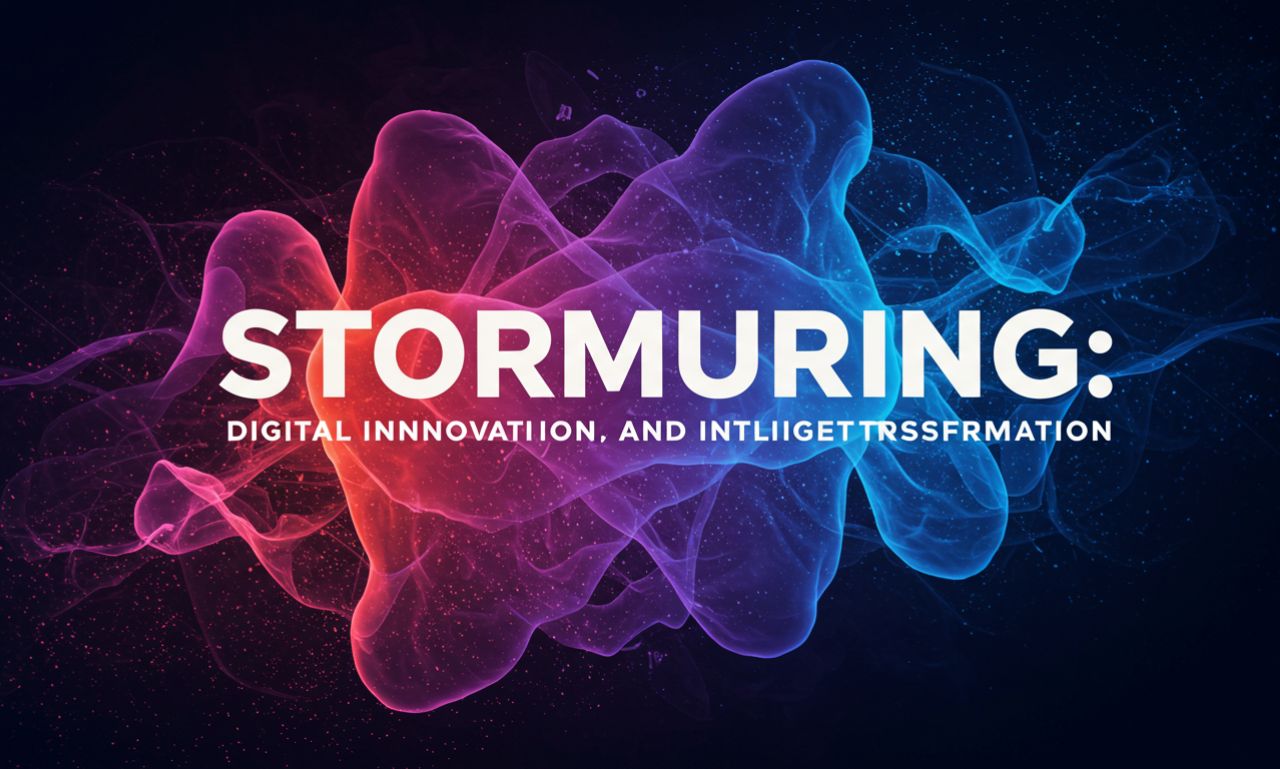In a rapidly evolving digital world, the need for smarter, adaptive, and interconnected systems has never been greater. One emerging concept that embodies this evolution is Stormuring — a term increasingly associated with innovation, data intelligence, and the fusion of technology with human creativity.
Though relatively new, Stormuring is shaping conversations across industries, from IT and artificial intelligence to marketing, business strategy, and digital transformation. It represents not just a system or platform, but a mindset that revolves around adaptability, intelligence, and collaboration.
In this article, we’ll explore what Stormuring is, how it works, its key applications, benefits, and how it could redefine the way we think about innovation in the years ahead.
What Is Stormuring?
Stormuring can be understood as a dynamic approach or framework that focuses on combining data-driven insights, artificial intelligence, and human decision-making to create more responsive and efficient digital systems.
The name “Stormuring” itself symbolizes storm-like energy — constant movement, change, and evolution — merged with structuring, which implies order and precision. Together, these elements define a concept that encourages the organized use of chaos — turning rapid technological change into structured innovation.
At its core, Stormuring promotes the synchronization of:
-
Data intelligence (information gathering and analysis)
-
Automation (using AI to streamline tasks)
-
Creativity (human-led innovation)
-
Adaptability (evolving systems and processes in real time)
This blend allows organizations and individuals to respond faster, innovate smarter, and thrive in an unpredictable digital ecosystem.
The Philosophy Behind Stormuring
The philosophy of Stormuring is built on one simple idea: the digital world doesn’t stand still — and neither should we. Technology evolves like a storm — fast, powerful, and often unpredictable. Instead of resisting change, Stormuring encourages embracing and structuring that energy into progress.
This philosophy is often expressed through three key principles:
-
Continuous Evolution:
Systems, businesses, and individuals must adapt to technological shifts without losing focus or direction. -
Structured Innovation:
Creativity is valuable only when organized and applied effectively. Stormuring provides a framework to channel innovation strategically. -
Human-AI Collaboration:
Machines can process data; humans can imagine possibilities. Stormuring thrives on combining both strengths for greater impact.
Through these principles, Stormuring creates a balance between control and flexibility — essential for success in today’s rapidly changing world.
The Origins and Development of Stormuring
The concept of Stormuring originated in discussions around how organizations could survive the accelerating pace of digital transformation. Businesses were facing constant technological disruptions — new tools, new algorithms, new expectations.
Stormuring emerged as a strategic model for digital resilience. It proposed that instead of overhauling systems with every new innovation, companies could adopt adaptive structures that evolve naturally.
Over time, the idea of Stormuring has grown beyond business. It is now applied in:
-
Technology design (adaptive systems)
-
AI modeling (self-learning frameworks)
-
Creative industries (data-informed design)
-
Education and training (adaptive learning environments)
This adaptability has made Stormuring a powerful concept across multiple fields.
How Stormuring Works
At a practical level, Stormuring operates through a cycle of continuous feedback and intelligent adaptation. Here’s how it works:
1. Data Collection
Every digital system produces data — from user behavior to market trends. Stormuring starts with gathering this information efficiently and ethically.
2. Intelligent Analysis
Using AI and analytics tools, the system processes the data to find patterns, opportunities, and potential problems.
3. Adaptive Response
Based on insights, actions are taken — automated changes, strategic decisions, or creative innovations. These responses improve performance and adaptability.
4. Continuous Feedback
Results are monitored, and new data feeds back into the system, creating an ongoing cycle of improvement.
This loop allows Stormuring-based systems to stay resilient, informed, and future-ready — even in volatile environments.
Applications of Stormuring in Modern Industries
The power of Stormuring lies in its versatility. It can be applied across many industries, improving efficiency, innovation, and strategic outcomes.
1. Information Technology (IT)
In IT, Stormuring enhances system agility, helping networks and applications respond to real-time challenges like security threats or performance drops.
2. Artificial Intelligence and Machine Learning
AI models benefit from the Stormuring approach by learning continuously from data feedback, improving accuracy and adaptability without constant reprogramming.
3. Business Strategy
Companies use Stormur-ing for dynamic planning — aligning operations with market shifts and consumer trends through predictive data analysis.
4. Digital Marketing
Marketers apply Stormur-ing to adjust campaigns based on live analytics, ensuring messages remain relevant and effective.
5. Education
In e-learning platforms, Stormur-ing personalizes education by adjusting content and difficulty levels based on a learner’s progress.
6. Healthcare
Stormuring supports predictive healthcare — anticipating patient needs, optimizing resources, and improving diagnosis accuracy through real-time data.
7. Smart Cities and IoT
In smart city planning, Stormu-ring helps manage interconnected systems like energy grids, traffic flow, and communication networks efficiently.
Benefits of Implementing Stormuring
Organizations adopting Stormur-ing enjoy a wide range of benefits that enhance their competitiveness and long-term sustainability.
1. Real-Time Decision Making
Stormuring enables data-driven decisions based on current insights, minimizing risks and improving outcomes.
2. Increased Efficiency
Automated and adaptive processes reduce manual workload, speeding up operations while maintaining quality.
3. Innovation Acceleration
By merging human creativity with AI intelligence, Stormur-ing speeds up innovation cycles and product development.
4. Improved Resilience
Businesses become more resistant to market fluctuations and technological disruptions.
5. Better Customer Experience
With continuous learning and feedback, companies can deliver more personalized and meaningful experiences to users.
6. Sustainable Growth
Stormur-ing encourages long-term thinking, ensuring progress aligns with ethical and environmental standards.
Stormuring and Artificial Intelligence
Artificial Intelligence plays a central role in Stormuring. The concept relies heavily on machine learning, predictive modeling, and automation to support decision-making.
However, unlike traditional AI systems that follow rigid algorithms, Stormur-ing AI is designed to be context-aware and self-evolving. It doesn’t just follow rules — it learns from behavior, adapts to change, and improves over time.
This approach makes Stormuri-ng-based AI more flexible, ethical, and human-aligned — capable of supporting complex systems while remaining responsive to social and cultural needs.
Stormuring in Creative Industries
Beyond data and analytics, Stormur-ing also has a place in the creative world. Artists, designers, and creators use it as a framework to blend logic with imagination.
For instance:
-
Graphic designers use Stormur-ing-inspired workflows to balance data insights (like color psychology) with creative vision.
-
Musicians and digital artists use algorithms that evolve based on audience interaction.
-
Filmmakers analyze real-time feedback to adjust storytelling elements for streaming audiences.
In all these cases, Stormur-ing brings structure to the chaos of creativity — allowing innovation to flourish without losing focus.
Challenges and Future Potential of Stormuring
While the potential of Stormur-ing is vast, implementing it effectively requires overcoming several challenges:
-
Data Privacy:
Stormur-ing depends on continuous data collection, which must comply with ethical and legal standards. -
Technical Complexity:
Building adaptive systems demands expertise in AI, cloud computing, and cybersecurity. -
Human Adaptation:
For Stormur-ing to work, teams must embrace change, flexibility, and ongoing learning.
However, these challenges also present opportunities. As more organizations invest in digital intelligence, the demand for Stormur-ing experts — professionals skilled in integrating adaptability with innovation — will continue to rise.
The Future of Stormuring
Looking ahead, Stormur-ing could become a foundational model for how organizations approach technology and innovation. As industries shift toward automation, cloud ecosystems, and data-centric operations, Stormur-ing will guide the balance between speed and structure, intelligence and ethics, automation and creativity.
Predictions for the future include:
-
Integration of quantum computing into Stormuring frameworks.
-
Expansion into global sustainability projects.
-
Development of AI-human hybrid teams guided by Stormuring principles.
By 2030, experts believe that companies using Stormuring-based systems will outperform competitors in innovation, customer satisfaction, and adaptability.
Conclusion: Stormuring as the New Paradigm of Innovation
In a world where technology evolves faster than ever, Stormur-ing offers a blueprint for intelligent adaptation and creative progress. It’s not just a strategy or a system — it’s a mindset that embraces change, learns from data, and builds structure amid chaos.
From IT and AI to education and art, Stormur-ing is already transforming the way we innovate, collaborate, and think. By combining the storm of digital transformation with the structure of strategic design, Stormur-ing represents the next great leap in human-technology collaboration.
Whether you’re an entrepreneur, developer, educator, or creative thinker, adopting the principles of Stormur-ing could be your key to thriving in the digital future — one that rewards flexibility, intelligence, and vision.

